Waiheke Gulf News 9 September 2021
The week before Aotearoa’s Lockdown I visited Kiya Nancarrow in her Rocky Bay studio. I’ve enjoyed Kiya’s work for years and find the fluidity and motion of both the ceramic or steel that she uses to create her pieces intriguing. Even though her work has a delicate movement to it, the industrial machinery she uses creates an interesting dichotomy.
Michelle Barber: Where did you grow up?
Kiya Nancarrow: Wanganui. My mother had a farm north of Wanganui where we spent every single weekend although we lived in Wanganui township. Eventually mother wanted to move to the farm permanently as her heart was out there and she thought we’d all stay to help her but we all ran for the hills.
I trained as an occupational therapist and a teacher but every weekend I’d go to Welly in my Morris Minor to meet container ships to see if I could work for my passage, I was willing to go anywhere to get away. I finally met a captain of a German ship who said there are two conditions: 1. You have to pay $500.00 in case you’re lazy and 2. You can’t have sex with any of the sailors. We shook on it. I then had to wait for the ship to come around NZ before I could board. In the interim I told a friend about this and she talked her way onto the ship and took the last berth! It was the first time I experienced betrayal. My father felt sorry for me and helped me get to London in the end. Straight away I had work as an occupational therapist. I did that for a long while and also trained as a psychotherapist but at 29 decided I wanted to go to art school which was the whole reason I left New Zealand. Four years of art school and I was in absolute heaven working with ceramics. I went to London for 6 months and stayed for 20 years.
MB: Tell me about the movement in your work.
KN: I don’t know where it came from really. When I lived in London, I studied Buddhism which connects and flows through everything. Although I’ve never perfected it, I’m constantly trying to get the perfect representation of movement, always trying to capture the seamless action of movement. The best compliment I’ve ever had was when a woman came into a gallery and started moving her body and she was very rhythmic, this is how she looked and engaged with the piece.
MB: Do you study dance at all or look at it for your work? It feels like a natural connection to me.
KN: Dance is a reflection of energy or movement which is reflected in everything we do. In London I would watch ballet or modern dance but the movement of my work is coming from my gut, if my head is there it throws everything off but if i’m working from my gut and my instinct then the piece flows naturally.
MB:What do you prefer working with clay or steel?
KN: At Uni I had these ceramic pieces that I’d drop from a ladder trying to create the movement I was after. I now throw things on a wheel and then have a small window where I can bend it and create something with movement. These pieces can’t be high fired because they get damaged in the kiln and the electricity in Rocky Bay is so low that it’s hard to run the kiln. Clay really speaks the language to me better than steel but it’s delicate and can break when shipping.
When I started working with steel it was about making bigger and stronger work so that it could withstand shipping. The artist Jay Lloyd designed a steel press for me and a man named Brian made it on the island.
The work then needs to be galvanised which is done in town and is dipped in 400 degrees of melted zinc which is an incredible process to watch. The piece then comes back, I sand them down, they then go back to be powder coat painted; a process that electrically cooks the paint onto the steel.
Corten Steel though is my favourite metal to work with because it creates colour all by itself and doesn’t have to be painted. Corten has its own beautiful, copper colour.
MB: What are you working on now?
KN: Currently, I’m working on a steel piece going to King’s College. I have more bolting and welding to do.
MB: How’s your welding career going?
KN: Slowly, but good! It’s hard to see behind the welding mask and electricity and gas are a scary combination. If I can weld myself it makes working on the steel press a lot easier. My studio is like being a kid mucking around with these materials.
MB: How long does a piece take you to finish? All up, sourcing, going to town, etc.?
KN: It can take a couple of days if all the elements fall into place and the planets align but really it takes a few weeks with galvanising and powder coating, if I’m lucky.
MB: I called Kiya this week to see how her lockdown was going for her.
KN: I’m definitely more productive under lockdown, it hasn’t stopped me yet. And considering there is a limited supply of materials on hand makes you work with what you have in your coffers.
You can visit Kiya Nancarrow’s Rocky Bay studio after levels go down, call to book an appointment at 0211476994.
Michelle Barber is the owner/operator of Artisphere.co.nz

